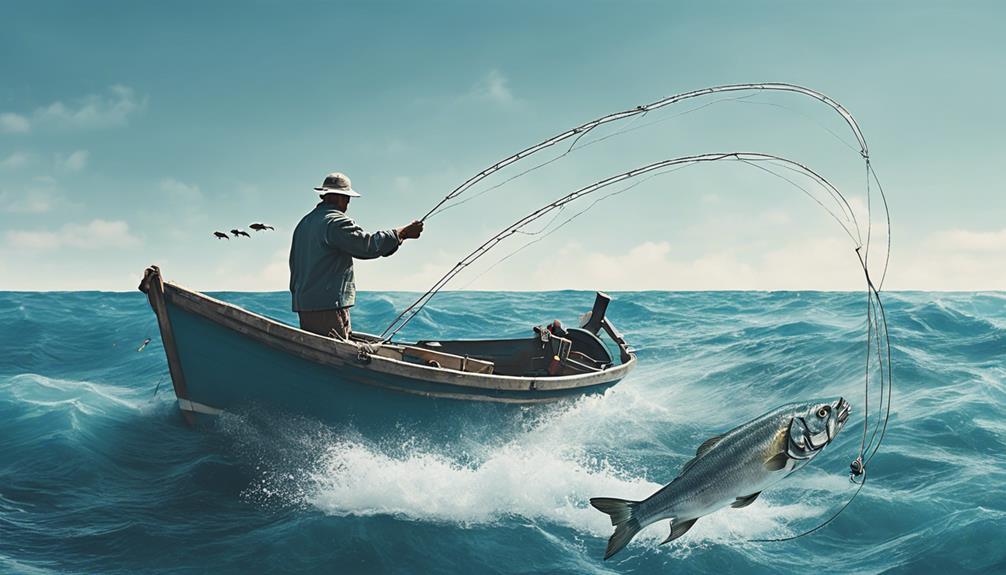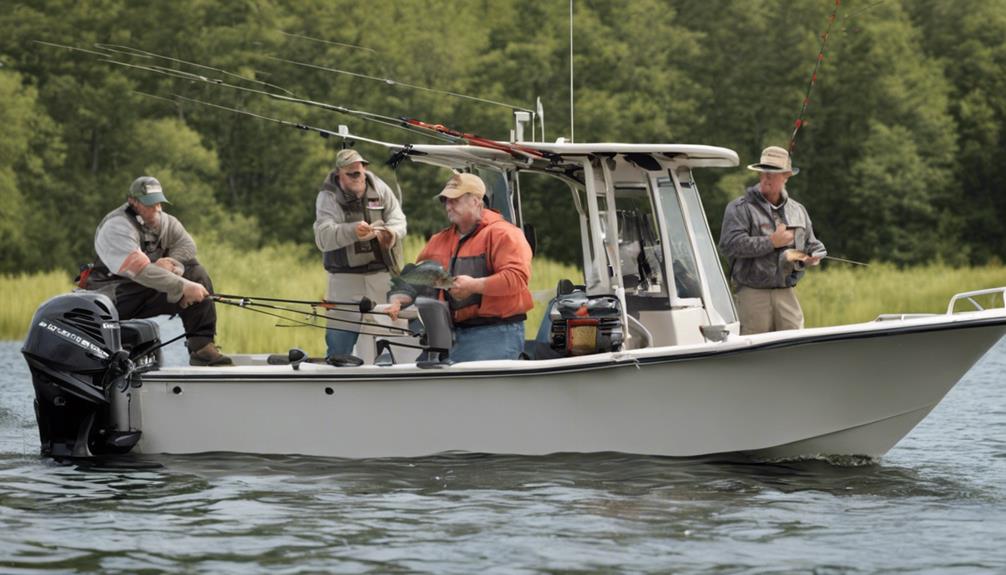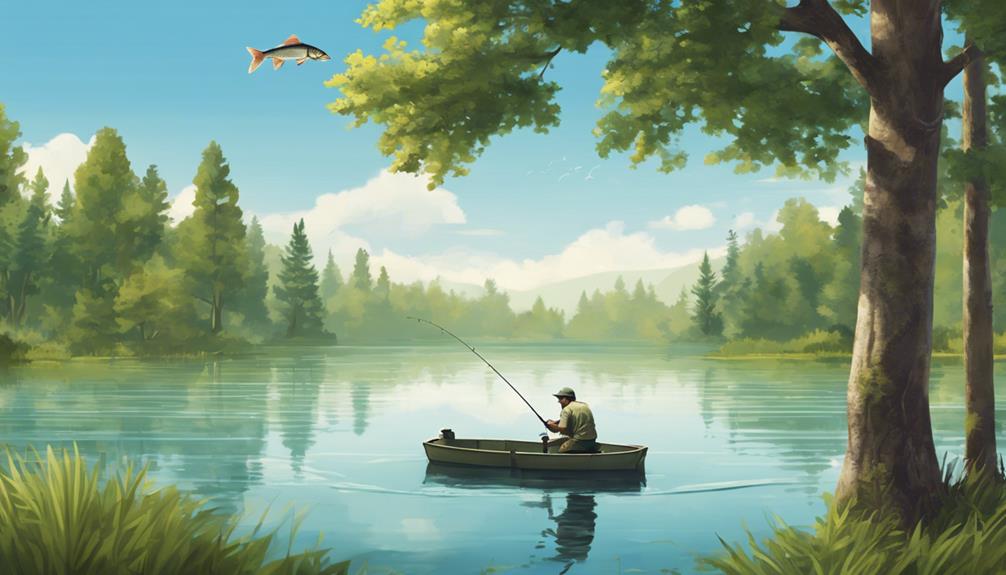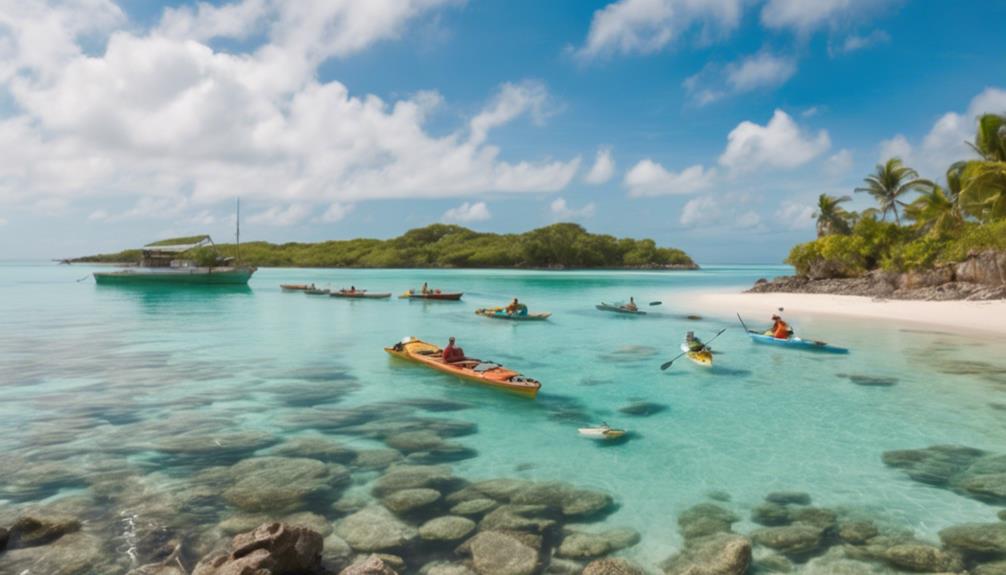Did you know that according to the Food and Agriculture Organization of the United Nations, around 33% of global fish stocks are overfished? With the increasing demand for seafood, it's crucial to adopt sustainable fishing practices for conservation.
By following the top 12 guidelines, you can make a significant impact on preserving marine ecosystems and ensuring a healthy future for fisheries. From selective fishing gear to community education, each practice plays a vital role in safeguarding our oceans.
So, why not take the first step towards sustainable fishing today?
Selective Fishing Gear
To minimize bycatch and target specific species, consider utilizing selective fishing gear. Eco-friendly gear and sustainable harvesting practices are essential components of responsible fishing. By using selective fishing gear, you can choose the species you want to catch while minimizing the capture of non-targeted marine life. This approach helps in reducing the negative impact on the marine ecosystem.
One example of eco-friendly gear is the use of circle hooks instead of traditional J-hooks when fishing. Circle hooks are designed to hook the fish in the corner of the mouth, reducing injury and increasing survival rates for the released ones. This simple switch in gear can make a significant difference in promoting sustainable fishing practices.
Another method is the use of escape panels in fishing nets. These panels allow undersized or non-targeted species to escape, contributing to the conservation of fish populations and maintaining a balanced ecosystem. By incorporating such features into your fishing gear, you actively participate in preserving marine biodiversity.
Avoiding Overfishing
Implement sustainable fishing quotas to prevent overfishing and safeguard marine resources for future generations. Sustainable management practices are crucial to ensure responsible harvesting of fish populations without depleting them. Overfishing occurs when more fish are caught than can be naturally replenished, leading to the decline of fish stocks and disrupting marine ecosystems. By setting sustainable fishing quotas based on scientific data and monitoring the amount of fish being caught, fisheries can prevent overfishing and promote long-term conservation.
Sustainable management involves regulating fishing activities to maintain a balance between the number of fish caught and the population's ability to reproduce and replenish itself. This approach aims to preserve fish stocks at healthy levels while supporting the livelihoods of fishermen and the food security of communities that depend on seafood. Responsible harvesting practices, such as avoiding the capture of undersized fish or limiting fishing in vulnerable areas, also contribute to preventing overfishing and protecting marine biodiversity.
Implementing Catch Limits
By setting catch limits, fisheries can effectively control the amount of fish being harvested to ensure sustainable fishing practices and protect marine ecosystems. Monitoring compliance with these limits is crucial to their success. Fisheries must enforce consequences for those who exceed the set catch limits to deter overfishing.
Collaborating with scientists for data collection is essential to establish accurate catch limits that align with the health of fish populations.
To implement catch limits successfully, fisheries need to establish clear regulations and quotas based on scientific research. Collaborating with marine biologists and oceanographers can provide valuable insights into fish populations and their reproduction rates. By utilizing this data, fisheries can set catch limits that allow for sustainable harvesting without depleting fish stocks.
Monitoring compliance with catch limits requires regular inspections and audits. Fisheries should invest in technology and personnel to enforce these limits effectively. Enforcing consequences for violators is vital to deter illegal fishing practices and protect marine ecosystems. By imposing fines or penalties on those who exceed catch limits, fisheries can promote responsible fishing behaviors.
Protecting Habitat Areas
One effective way to ensure the preservation of marine ecosystems is by establishing and protecting habitat areas. By safeguarding these crucial habitats, you can help maintain biodiversity and ensure the sustainability of fish populations.
Here are some key actions you can take to protect habitat areas:
- Establish Marine Sanctuaries: Supporting the creation of marine sanctuaries can provide safe havens for fish, corals, and other marine species to thrive without the threat of overfishing or habitat destruction.
- Conduct Habitat Restoration: Engaging in habitat restoration projects such as replanting seagrass beds or restoring coral reefs can help revitalize degraded habitats and support the recovery of fish populations.
- Monitor and Enforce Protection: Regular monitoring of habitat areas and strict enforcement of protection regulations are essential to ensure that these areas remain undisturbed and provide a safe environment for marine life.
- Collaborate with Conservation Organizations: Partnering with conservation organizations that focus on habitat protection and restoration can amplify your efforts and contribute to the long-term health of marine ecosystems.
Supporting Fishery Regulations
To effectively promote sustainable fishing practices for conservation, actively supporting fishery regulations is crucial for ensuring the responsible management of fish stocks. Policy advocacy plays a significant role in shaping regulations that promote sustainable fishing practices. By advocating for policies that prioritize long-term conservation goals and the well-being of marine ecosystems, you can contribute to the preservation of fish populations for future generations. Engaging with stakeholders, including government agencies, fishing communities, and conservation organizations, is essential for developing effective regulations that are widely accepted and implemented.
Additionally, supporting fishery regulations helps meet the growing sustainable sourcing demands of consumers. As more people become aware of the importance of sustainable fishing practices, there's a shift in market demand towards responsibly sourced seafood. By complying with and advocating for regulations that promote sustainable fishing methods, you can align with market trends and contribute to the protection of marine biodiversity.
Embracing Bycatch Reduction
Embrace the practice of reducing bycatch to minimize the impact on non-target species and promote sustainable fishing methods. Bycatch management is crucial for species protection and plays a significant role in conservation efforts and sustainable fishing practices. Here are some key points to consider:
- Implement Selective Gear: Using selective fishing gear can help target specific species, reducing the chances of catching non-target species.
- Modify Fishing Techniques: Altering fishing techniques, such as changing the time or location of fishing activities, can help minimize the bycatch of vulnerable species.
- Use Turtle Excluder Devices (TEDs): Installing TEDs in fishing nets can prevent sea turtles and other large marine creatures from getting entangled, reducing bycatch significantly.
- Support Research and Innovation: Investing in research for developing new technologies and methods to reduce bycatch can lead to more sustainable fishing practices in the long run.
Promoting Eco-friendly Practices
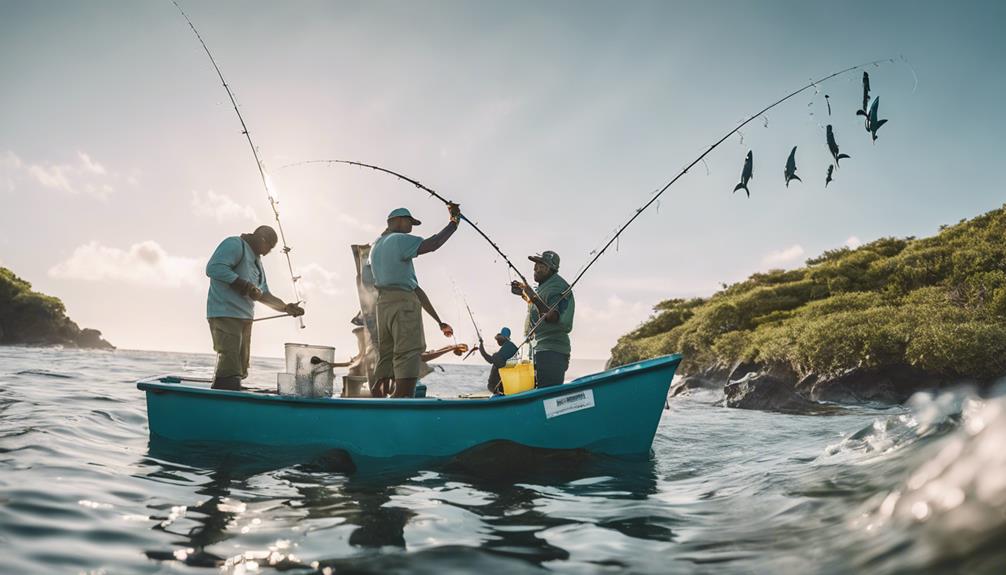
To enhance the sustainability of fishing practices and further conservation efforts, consider encouraging the adoption of eco-friendly methods in the fishing industry. By promoting eco-friendly practices such as marine stewardship and sustainable sourcing, you can actively contribute to the preservation of our oceans and aquatic ecosystems.
One key aspect of promoting eco-friendly practices in fishing is emphasizing marine stewardship. This involves taking responsibility for the well-being of marine environments by implementing sustainable fishing practices that ensure the long-term health of fish populations and their habitats. By supporting fisheries that adhere to marine stewardship principles, you help protect biodiversity and safeguard the future of our oceans.
Another crucial eco-friendly practice is sustainable sourcing. By choosing seafood products from fisheries that follow sustainable sourcing guidelines, you can help reduce overfishing and minimize the environmental impact of fishing activities. Sustainable sourcing not only supports the health of fish populations but also promotes the overall well-being of marine ecosystems.
Engaging in Community Education
Engage your community through education on sustainable fishing practices to raise awareness and promote conservation efforts. Community outreach plays a crucial role in preserving marine ecosystems and ensuring the longevity of fish populations. By organizing educational workshops, you can empower individuals to make informed decisions that contribute to sustainable fishing practices.
Here are some effective ways to engage in community education:
- Host Educational Workshops: Organize workshops to educate community members about sustainable fishing techniques, regulations, and the importance of conservation.
- Collaborate with Local Schools: Partner with schools to integrate lessons on sustainable fishing into their curriculum, fostering a sense of environmental responsibility in students from a young age.
- Utilize Social Media Platforms: Use social media to share educational content, tips on sustainable fishing, and updates on conservation initiatives, reaching a wider audience and encouraging participation.
- Engage in Hands-On Activities: Arrange hands-on activities like beach clean-ups, fishing gear recycling programs, or sustainable fishing demonstrations to provide practical experience and reinforce learning.
Frequently Asked Questions
How Do Sustainable Fishing Practices Impact the Local Economy and Community Livelihoods?
When you prioritize sustainable fishing practices, local partnerships thrive, boosting the local economy. By ensuring fish populations are healthy and not overexploited, you contribute to long-term economic benefits for the community.
Sustainable practices help maintain a balance that supports both the environment and livelihoods, creating opportunities for growth and stability. Your efforts in sustainable fishing can have a positive ripple effect on the local economy and community livelihoods.
What Role Do Consumer Choices Play in Promoting Sustainable Fishing Practices?
Consumer awareness is key in promoting sustainable fishing practices. By making informed choices about the seafood you purchase, you can encourage the fishing industry to adopt more sustainable methods.
Your decisions impact demand, which can prompt policy regulations for better fishing practices. So, next time you're at the market, consider the source of your seafood and choose options that support sustainable fishing for the future of our oceans.
Are There Any Innovative Technologies Being Used to Improve Sustainability in the Fishing Industry?
Innovative technologies like data analytics and monitoring systems are revolutionizing the fishing industry. Aquaculture integration and technology advancements are crucial for sustainability. These tools help track fish populations, reduce bycatch, and improve fishing practices.
Embracing these advancements can lead to a more sustainable future for our oceans and ensure that fishing practices are environmentally friendly and conservation-focused.
How Do Climate Change and Environmental Factors Affect Sustainable Fishing Efforts?
Climate change and environmental factors have a significant impact on sustainable fishing efforts. Overfishing can disrupt marine ecosystems by depleting fish populations, leading to imbalances in the food chain.
Rising sea temperatures and ocean acidification also affect fish habitats and breeding grounds. Adapting to these changes through better management practices and conservation efforts is crucial to ensure the long-term health of marine ecosystems and sustainable fishing practices.
What Are Some Common Challenges Faced by Fishermen When Transitioning to Sustainable Practices?
When transitioning to sustainable practices, fishermen often face challenges like adapting to new gear, changing fishing methods, and navigating regulations. Support systems, such as training programs and financial assistance, can help make this shift smoother.
It's essential to have resources available to assist with the adjustment process and ensure a successful move towards sustainable fishing practices.
Conclusion
In conclusion, by implementing sustainable fishing practices such as selective gear, catch limits, and habitat protection, you can contribute to the conservation of marine ecosystems.
Avoiding overfishing, reducing bycatch, and supporting regulations are key steps in preserving fish populations for future generations.
Embracing eco-friendly practices and educating your community on the importance of sustainable fishing will help ensure a healthy and thriving ocean environment for years to come.
Make a difference today by adopting these practices in your fishing endeavors.
